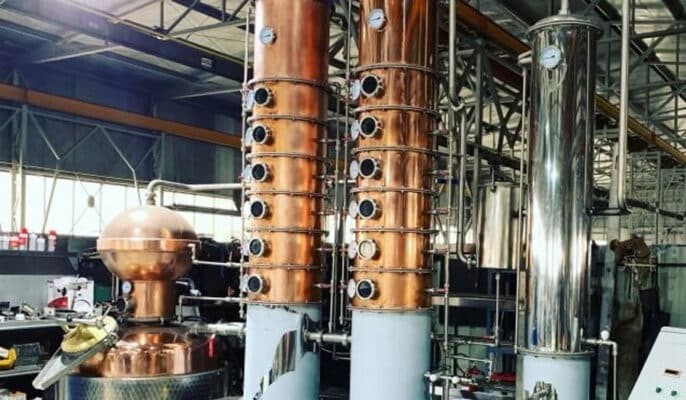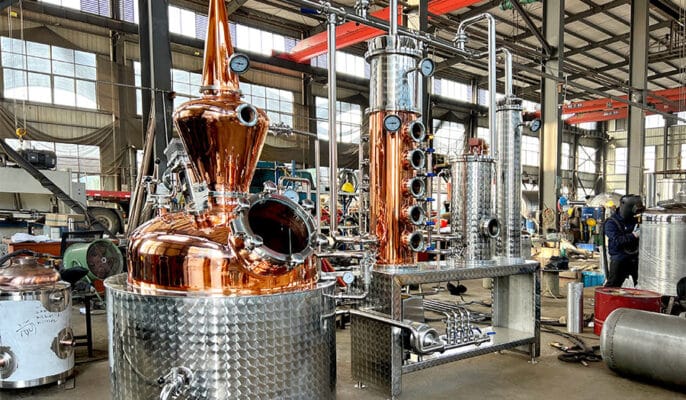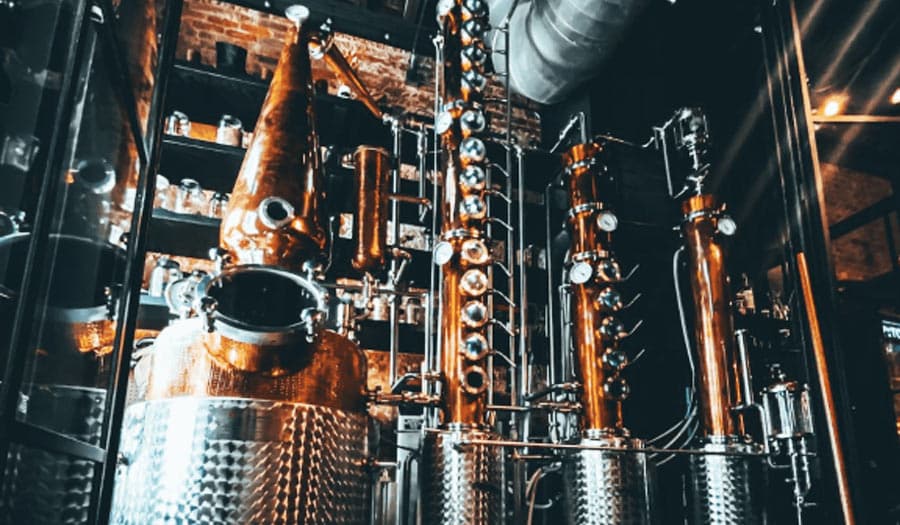Distilleerapparatuur De selectie en configuratie van distilleerapparatuur heeft een directe invloed op de smaak, het aroma en de kwaliteit van de uiteindelijke whiskey. Of je nu een thuisbrouwer bent of een commerciële producent, het kiezen van de juiste apparatuur is essentieel voor het verkrijgen van whiskey van hoge kwaliteit. Deze korte handleiding geeft een overzicht van de belangrijkste componenten van distilleerapparatuur en hun belang bij het distilleren van whiskey.
Basisproces van whisky brouwen
- Mouten: Gerst is een van de belangrijkste ingrediënten van malt whisky en moet speciaal verwerkt worden om de suikers eruit te halen. In dit stadium wordt de gerst geweekt in water en laat men hem ontkiemen. Het kiemproces is voorbij wanneer de gerst gedroogd wordt in een oven.
- Mashen: Nadat het mouten is voltooid, is de gedroogde gerst klaar om gemaischt te worden. Tijdens het maischen zetten enzymen zetmeel om in suikers. Zodra de suikers zijn geëxtraheerd, kan de vloeistof (die nu wort wordt genoemd) de volgende fase ingaan en alcohol worden.
- Fermentation: During the fermentation process, the wort is transferred to a large wooden container called a fermenter. Here, yeast is added. Mixing the wort with yeast converts the sugars into alcohol, called “fermentation liquid”. This process takes 48-96 hours and can produce a variety of flavors depending on the fermentation time and the type of yeast strain. The alcohol content of the liquid before distillation is about 7-10%.
- Distillation: The lees pass through a still, usually a “lees still” and a “spirit still”. The still is usually made of copper and helps remove unwanted odors and flavors from the spirit. The liquid is heated and refined, allowing the process to happen again. Most whiskeys are distilled twice, but some are distilled three times. At the end of this stage, a high-quality spirit is produced.
- Rijping: Een belangrijk onderdeel van het productieproces is rijping. Bijna alle whisky's worden gerijpt in houten vaten, meestal gemaakt van eikenhout. De vaten geven de whisky zijn kleur en andere kenmerken. De vaten worden opgeslagen in pakhuizen zodat de whisky kan rijpen.
- Botteling: Nadat de whisky gerijpt heeft, heeft hij een alcoholpercentage van minstens 40%. De whisky kan koud gefilterd worden om te voorkomen dat hij troebel wordt wanneer er ijs wordt toegevoegd.

Soorten distilleerapparatuur nodig voor distilleerderijen
Distilleerderij warmtebron
De verwarmingsbron wordt gebruikt om de gefermenteerde vloeistof in de distilleerder te verwarmen, wat meestal wordt onderverdeeld in elektrische verwarming en stoomverwarming.
- Elektrische verwarming: Het elektrische verwarmingssysteem is eenvoudig en gemakkelijk te gebruiken, kan de temperatuur nauwkeurig regelen en is geschikt voor kleine distilleerderijen. De kosten zijn echter hoog en langdurig gebruik zal de elektriciteitsrekening doen stijgen.
- Stoomverwarming: Het stoomverwarmingssysteem gebruikt een ketel om stoom op te wekken en stuurt de stoom via een pijp naar de distilleerder. Het voordeel van deze methode is gelijkmatige verwarming en is geschikt voor grootschalige productie, maar het vereist complexere faciliteiten en onderhoud.
Stoker
- Pot distilleerketel: De pot distilleerketel is meestal gemaakt van koper, met een ronde vorm en een lange hals aan de bovenkant. Dit ontwerp zorgt voor meer contact met de stoom tijdens het distillatieproces, waardoor onzuiverheden effectief worden verwijderd en de smaak van de wijn behouden blijft. Geschikt voor kleine distilleerderijen, die meestal maar een beperkt aantal grondstoffen tegelijk kunnen verwerken, meer smaakcomponenten kunnen behouden en geschikt zijn voor het brouwen van single malt whisky.
- Kolom distilleerketel: Kolom distilleerketels worden meestal gebruikt voor grootschalige productie. Hun structuur is complexer en bestaat uit meerdere verticale distillatiekolommen. Deze distilleerkolom kan 24 uur ononderbroken produceren en is geschikt voor grootschalig brouwen. Het brouwen is efficiënt en brengt de alcoholconcentratie in korte tijd op het gewenste niveau.
Condensator
De condensor is verantwoordelijk voor het terugkoelen van de damp die in de distilleerketel wordt geproduceerd naar een vloeibare toestand. Hij bestaat meestal uit een spoel of pijp waar koud water doorheen circuleert, waardoor de damp condenseert en zich verzamelt als distillaat. De condensor kan passief zijn (met behulp van omgevingslucht of water) of actief (met behulp van een koelmiddel zoals glycol), afhankelijk van de grootte en het ontwerp van de distilleerketel.
Vergister
De fgistingsvat is waar het gistingsproces plaatsvindt, waarbij suikers worden omgezet in alcohol en andere verbindingen. Voor een thuisbrouwer kan het gistingsvat een eenvoudig vat of vat zijn, terwijl het voor een commerciële producent een grotere tank kan zijn. Het gistingsvat moet gemaakt zijn van voedselveilig materiaal en voorzien zijn van luchtsluizen om gassen te laten ontsnappen en contaminatie te voorkomen.
Wortkuip
De wortkuip wordt gebruikt om water en graan of andere fermenteerbare ingrediënten te mengen om wort te maken. De kuip kan een valse bodem of een ander filtersysteem hebben om de vloeistof (wort) te scheiden van de vaste stoffen (graanresten) nadat de wort verwerkt is. Wortkuipen zijn essentieel voor de productie van whisky, bourbon en andere sterke dranken op basis van graan.
Andere hulpapparatuur
- Alcoholmeter: Een alcoholmeter wordt gebruikt om de alcoholconcentratie van gedistilleerde vloeistof te meten, zodat de geproduceerde whisky aan de normen voldoet.
- Transferpomp: Een transferpomp wordt gebruikt om gefermenteerde vloeistof van de fermentatietank naar de distilleerder, of om gedistilleerde vloeistof over te hevelen naar het rijpingsvat.
- Opslagtank: Opslagtanks worden gebruikt om gefermenteerde vloeistof, gedistilleerde vloeistof, enz. in op te slaan en zijn een belangrijke schakel in het wijnmaakproces.
Hoe whiskeybrouwapparatuur kiezen?
Productieschaal
Bepaal de productieschaal op basis van je behoeften, of het nu gaat om persoonlijk gebruik, kleinschalig handstoken of grootschalige commerciële productie. Kleine brouwerijen gebruiken misschien liever distilleerketels om de diversiteit en uniekheid van smaken te garanderen. Grote brouwerijen zijn meer geschikt voor kolombrouwinstallaties voor een efficiënte productie. Kies apparatuur die geschikt is voor jouw productievolume en groeiverwachtingen.
Budget voor apparatuur
De investeringskosten van de apparatuur zijn ook een belangrijke overweging. Maak een budget voor de aankoop van destillatieapparatuur en houd rekening met de initiële kosten en de bedrijfskosten op lange termijn. Hoewel apparatuur van hoge kwaliteit een hogere initiële investering kan vereisen, kan deze na verloop van tijd betere prestaties, efficiëntie en duurzaamheid leveren.
Materiaalkeuze
Kies duurzame en geschikte materialen voor het brouwen, meestal zijn roestvrij staal en koper gangbare keuzes. Zoek naar distillatieapparatuur die gemaakt is van hoogwaardige materialen zoals roestvrij staal of koper, die duurzaam, corrosiebestendig en gemakkelijk schoon te maken zijn. Vermijd apparatuur van inferieure materialen, omdat inferieure materialen de kwaliteit en veiligheid van de sterke drank kunnen beïnvloeden.
Automatiseringsniveau
De keuze van het juiste automatiseringsniveau hangt af van je productieschaal, budget en technische behoeften. Hooggeautomatiseerde apparatuur kan het destillatieproces volledig automatiseren, van verwarmen tot koelen tot scheiden en verzamelen van eindproducten, met minder handmatige tussenkomst. Een hoge mate van automatisering kan de efficiëntie en consistentie verbeteren, maar de initiële investering en onderhoudskosten kunnen hoog zijn.
Ondersteuning van leveranciers
Ondersteuning door de leverancier is erg belangrijk bij het kiezen van apparatuur voor het brouwen van whiskey. Biedt de leverancier tijdig technisch advies en probleemoplossende diensten om de normale werking van de apparatuur te garanderen? Biedt de leverancier bedrijfstrainingen, installatie, probleemoplossing en andere diensten? Micet group is een goede keuze om je te helpen problemen op te lossen.
Whisky Distilleerapparatuur Onderhoud
- Regular Cleaning: Clean and disinfect distilling equipment regularly to prevent contamination and odors of spirits. Follow the manufacturer’s recommended cleaning procedures and use food-grade cleaners.
- Veiligheidsmaatregelen: Volg bij het bedienen van destilleerapparatuur de veiligheidsrichtlijnen en -voorschriften, waaronder goede ventilatie, brandpreventiemaatregelen en persoonlijke beschermingsmiddelen zoals handschoenen en een veiligheidsbril. Wees u bewust van de risico's die gepaard gaan met het omgaan met hete vloeistoffen, ontvlambare materialen en systemen onder druk.
- Routinematig onderhoud: Inspecteer distilleerapparatuur regelmatig op tekenen van slijtage, schade of storing en voer indien nodig routineonderhoud uit, zoals smering, vervanging van afdichtingen en kalibratie. Los eventuele problemen onmiddellijk op om stilstand te voorkomen en optimale prestaties te garanderen.

FAQ
Wat zijn de belangrijkste onderdelen van whiskydestillatieapparatuur?
Het bestaat voornamelijk uit een distilleerder (ketel of kolom), condensor, fermentor, verwarmingssysteem, opslagtank en regelsysteem.
Met welke factoren moet je rekening houden bij het kiezen van een distilleerder?
Er moet rekening worden gehouden met de capaciteit, het materiaal (zoals koper of roestvrij staal), het ontwerptype (ketel of kolom) en de destillatie-efficiëntie.
Hoe kan de veiligheid van het destillatieproces worden gegarandeerd?
Zorg ervoor dat de apparatuur voldoet aan de plaatselijke voorschriften, regelmatig wordt onderhouden en geïnspecteerd en is uitgerust met de nodige veiligheidsvoorzieningen (zoals overdrukventielen).
Hoe belangrijk is de reiniging en het onderhoud van de apparatuur?
Regelmatig reinigen en onderhouden van apparatuur is de sleutel tot het garanderen van de productkwaliteit en het verlengen van de levensduur van de apparatuur.
Wat is het belang van leveranciersondersteuning?
Door een leverancier te kiezen die goede aftersalesservice en technische ondersteuning biedt, kunnen problemen bij het gebruik van apparatuur worden opgelost en kan een soepele productie worden gegarandeerd.




